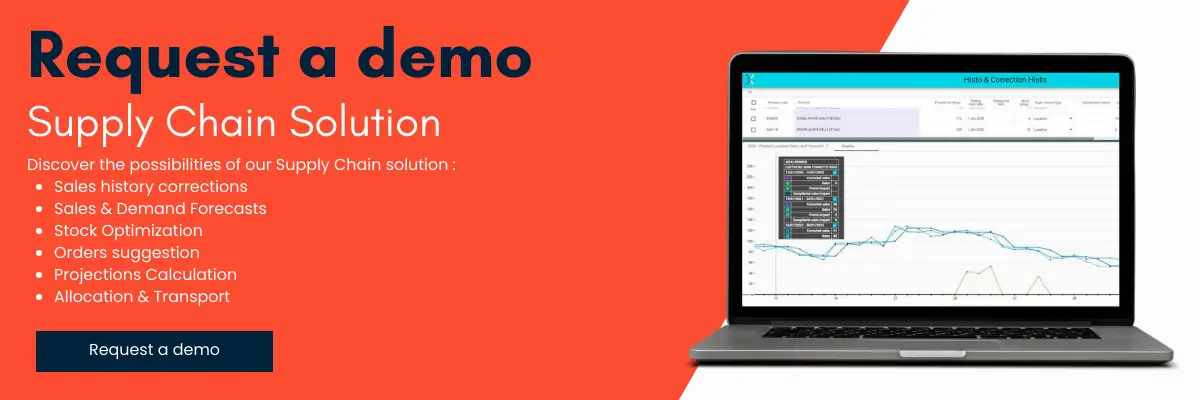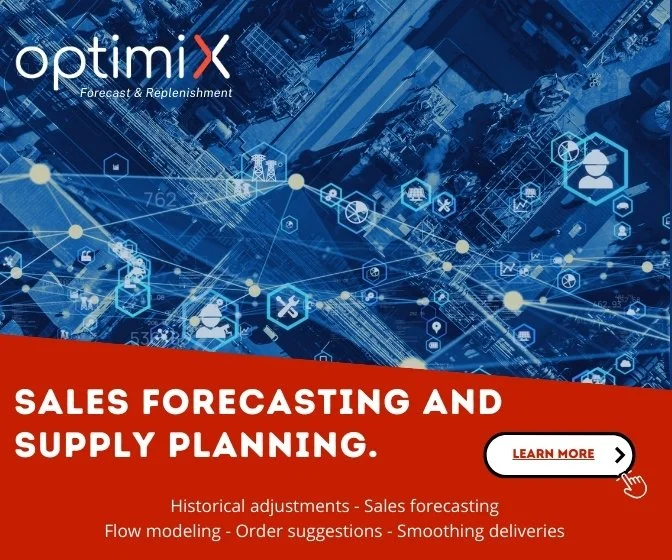The key point of good supply management is minimizing the Working Capital Requirement (WCR). WCR represents the amount of capital tied up in inventory, trade receivables and trade payables necessary to maintain ongoing business operations. Reducing the WCR frees up liquidity and improves the profitability of the company.
One of the keys to achieving this lies in precise inventory management and a robust demand forecasting solution. Indeed, the ability to accurately anticipate fluctuations in demand allows companies to better plan their purchases, adjust their inventory levels and reduce working capital requirements, which directly translates into improved productivity. profitability.
In this article, we will explore how these two elements can be combined to optimize WCR and improve the overall profitability of retail companies.
We will examine the importance of demand forecasting in inventory management, the challenges associated with inventory management and their impact on WCR, and the key role of artificial intelligence (AI) in optimizing the BFR. Finally, we will provide practical tips for effectively integrating demand forecasting into inventory management and maximizing business benefits.
The Stock Challenge and WCR Optimization
Challenges Related to Inventory Management and Impact on WCR
Stock management constitutes a major challenge for retail companies and has a direct impact on Working Capital Requirements (WCR). Maintain adequate inventory levels while minimizing storage costs and avoiding waste stock shortages is a delicate balance to find.
Businesses face a variety of challenges, including demand volatility, changing market trends, fluctuating raw material costs and supplier delivery times. These challenges make inventory management complex and have a direct impact on working capital, by influencing the amount of capital tied up in inventory and the costs associated with their management.
Effective inventory management is closely linked to the optimization of Working Capital Requirements (WCR) in the retail sector. WCR represents the amount of capital tied up in inventory, trade receivables and trade payables necessary to maintain ongoing business operations. Reducing the WCR frees up liquidity and improves the profitability of the company.
Importance of Finding the Right Balance Between Inventory Levels and Storage Costs
One of the main challenges for hardtail businesses is finding the right balance between maintaining sufficient inventory levels to meet customer demand and minimizing the costs associated with excessive inventory. Excessive inventory leads to capital tying up and high inventory costs, which can have a negative impact on the company’s working capital. On the other hand, insufficient inventory levels can lead to stock-outs, lost sales and customer dissatisfaction, which can also negatively affect WCR.

The Importance of Demand Forecasting
In a dynamic business environment, the ability to anticipate future demand is essential for effective inventory management. Demand forecasting involves using historical data, statistical models, and advanced analytical techniques to estimate future sales of a product or product category. This forecast allows businesses to plan purchases, adjust inventory levels, and make informed inventory management decisions.
Demand Forecasting: An Essential Pillar of WCR in Retail
Demand forecasting is of capital importance in optimizing working capital requirements (WCR) in retail. Indeed, accurately anticipating fluctuations in demand allows businesses to better plan their purchases, reduce excess inventory levels and avoid stock-outs. This directly translates into an improvement in working capital, freeing up valuable funds otherwise tied up in unnecessary inventory.
To optimize WCR, retail businesses must take a strategic approach to inventory management, using data and analytics to make decisions on stock levels and inventory policies. This may include using techniques such as just-in-time (JIT) inventory management, which aims to reduce inventory levels by synchronizing supplies with actual demand, and inventory rotation, which involves selling older products before they become obsolete.
In addition, WCR optimization in retail can also be improved by improving the management of supplier payment deadlines and reducing customer debt recovery times. By negotiating more favorable payment terms with suppliers and implementing effective collection policies, businesses can reduce working capital requirements and improve cash flow.
Benefits of Accurate Demand Forecasting to Reduce Storage Costs
Accurate demand forecasting offers several tangible benefits for reducing inventory costs. First, by accurately identifying the products and quantities needed to meet customer demand, businesses can avoid excessive purchasing that leads to excess inventory. These excess stocks not only lead to high storage costs but also an increased risk of product obsolescence. By anticipating demand more accurately, businesses can also avoid stock-outs, which lead to hidden costs such as lost sales, reduced customer satisfaction, and the need for costly emergency shipping.
Accurate demand forecasting has many benefits for retail businesses. Firstly, it helps reduce the risks associated with excess inventory and stock-outs, ensuring that products are available when customers need them. This helps optimize sales and maximize revenue. Additionally, accurate demand forecasting also allows reduce inventory costs by avoiding excessive purchases and minimizing storage costs.
One of the main benefits of demand forecasting for WCR optimization is the reduction of excess inventory. By accurately anticipating future demand, businesses can avoid overstocking products that risk remaining unsold for a long period of time. This frees up valuable funds that would otherwise be tied up in unnecessary inventory, helping to reduce working capital and improve the company’s cash flow.
Additionally, accurate demand forecasting also helps minimize stock outs. By anticipating peaks in demand and seasonal trends, businesses can ensure they have adequate inventory levels to meet customer demand without having to place emergency orders or ship discounted products. strong. This reduces the risk of lost sales and customer dissatisfaction while maintaining optimal inventory levels, which helps optimize WCR.
In addition, better demand forecasting can also have a positive impact on supplier payment times. By more accurately anticipating supply needs, companies can negotiate more favorable payment terms with their suppliers, such as longer payment terms or early payment discounts. This can help reduce working capital requirements by allowing businesses to defer payments while maintaining sufficient inventory levels to meet customer demand.
Ultimately, effective inventory management and WCR optimization requires a strategic and holistic approach to supply chain management, using data, analytics and advanced technologies to make decisions and maximize profitability of the company. By taking a proactive approach and implementing effective policies and processes, Retail companies can improve their financial performance and strengthen their competitive position in the market.
Concrete Examples of Companies Having Improved their WCR Thanks to Better Demand Forecasting
Many durtail companies have already benefited from the adoption of advanced demand forecasting solutions to improve their WCR. For example, online retail giant Amazon uses machine learning algorithms to analyze data from past purchases, seasonal trends and other variables to accurately forecast future demand for millions of products. Using this approach, Amazon is able to maintain optimal inventory levels, reduce inventory costs, and improve overall profitability. Similarly, traditional retail companies such as Walmart and Target have invested heavily in AI-based demand forecasting solutions to optimize their inventory levels, reduce stock-outs, and improve their WCR. These examples illustrate the significant potential of demand forecasting to improve WCR and strengthen the competitiveness of durtail companies.

Bridging the Gap with Technology (AI)
Introduction to AI-based Technologies for Inventory Management and Demand Forecasting
Artificial intelligence (AI) plays a crucial role in WCR optimization in retail. Using advanced algorithms and machine learning techniques, AI-powered solutions can analyze large amounts of data in real-time, identify hidden trends and patterns, and provide accurate recommendations to optimize inventory levels and reduce storage costs. AI-powered inventory management systems use advanced algorithms to analyze sales, inventory and supplier data and provide recommendations on order quantities, replenishment times and pricing strategies. Similarly, AI-based demand forecasting algorithms use historical data, statistical models, and machine learning techniques to accurately anticipate future demand and adjust inventory levels accordingly.
The integration of artificial intelligence (AI) into inventory management and demand forecasting offers significant opportunities for retail companies in terms of optimizing Working Capital Requirements (WCR). AI allows businesses to better understand and anticipate customer demand, optimize inventory levels and reduce costs associated with inventory management, resulting in an overall improvement in working capital.
One of the key ways AI can help optimize WCR is by providing accurate recommendations on optimal inventory levels. AI-powered inventory management systems use advanced algorithms to analyze real-time sales, inventory and supplier data, and provide recommendations on order quantities, replenishment times and pricing strategies. By optimizing inventory levels, businesses can reduce costs associated with inventory management, such as storage costs, while maintaining high service levels for customers, helping to improve WCR.
Additionally, AI can also improve the accuracy of demand forecasting, which has a direct impact on WCR optimization. AI-driven demand forecasting algorithms use historical data, statistical models and machine learning techniques to identify trends, patterns and correlations in sales data, enabling more anticipation. precisely future demand. By more accurately anticipating customer demand, businesses can better plan purchases, reduce excess inventory and minimize the risk of stockouts, which helps improve WCR.
How AI Can Improve Demand Forecasting Accuracy and Optimize Inventory Levels
AI offers several benefits to improve the accuracy of demand forecasting and optimize inventory levels. First, by analyzing large amounts of data in real time, AI algorithms can identify hidden trends and patterns in sales data, enabling future demand to be accurately anticipated. Additionally, using machine learning techniques, AI-based systems can adapt and evolve according to changes in the business environment, allowing for continuous improvement in the accuracy of demand forecasts. By optimizing inventory levels based on demand forecasts, businesses can reduce inventory costs, avoid stock-outs, and improve overall profitability.
Additionally, AI can also help businesses optimize their pricing and promotion policies, which can have a significant impact on WCR optimization. By analyzing sales data and identifying patterns in customer purchasing behavior, businesses can implement dynamic pricing strategies and targeted promotions that drive demand while maximizing revenue profit margins. By maximizing revenue and reducing costs, these strategies help improve WCR and strengthen the overall profitability of the company.
Integrating AI into inventory management and demand forecasting offers significant benefits in terms of WCR optimization for retail companies. By providing accurate recommendations on inventory levels, improving the accuracy of demand forecasting, and optimizing pricing and promotion policies, AI enables businesses to reduce costs, optimize revenue, and improve overall profitability, which contributes to a significant improvement in the WCR and the financial health of the company.
Conclusion
In an increasingly competitive sector, effective management of WCR is essential to ensure the long-term financial health of companies. By leveraging technological advances in inventory management and demand forecasting, retailers can optimize their operations, free up cash and improve their overall profitability.
Integrating AI-based solutions into inventory management offers significant opportunities to improve operational efficiencies, reduce inventory costs, and minimize risks associated with inadequate inventory management.
By investing in integrated solutions and taking a proactive approach, retail businesses can position themselves for success in an ever-changing market. By optimizing their WCR, companies can strengthen their competitiveness, stimulate their growth and ensure their sustainability in the market.
Ultimately, effective WCR management is a key element of long-term success in the retail sector, and the adoption of advanced technology solutions plays a vital role in this goal.




